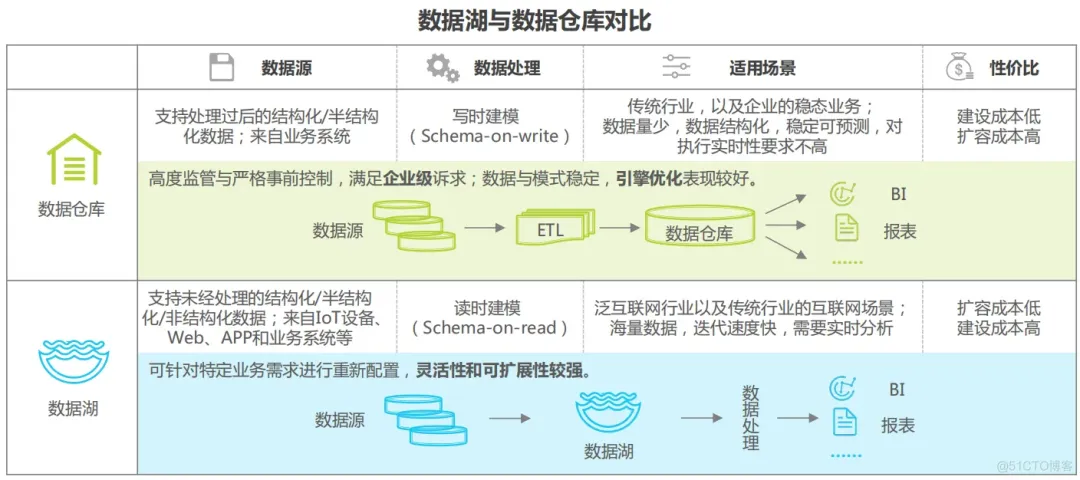Data Lake vs. Data Warehouse

In the data-driven business world, enterprises are faced with the challenge of storing, managing and analyzing massive amounts of data. In order to effectively utilize this data, data warehouses and data lakes have become two mainstream data management solutions.
Data lake is an advanced version of the traditional data warehouse concept in terms of source types, processing types, and structure for business analytics solutions. Data lakes are primarily implemented through the cloud and are architected using a variety of data storage and data processing tools, with managed service-based services used to process and maintain the data infrastructure of the data lake.
There is a famous analogy about data lakes by Pentaho CTO James Dickson who coined the term “data lake.” A data lake is similar to a lake where water enters from different sources and remains in its pristine form, while packaged bottled water is similar to a data mart where data is processed after multiple filtering and purification processes similar to that of a data mart.
A data lake is a repository that stores large amounts of raw data in its native format. From Azure to AWS, the power of having a proper data lake architecture lies in market speed, innovation, and scale for every enterprise. For large enterprises that no longer want to struggle with structural silos, these architectures can help you build organizational consensus and enable data ownership.
A data lake is like a large container, very similar to real lakes and rivers. Just like a lake has multiple tributaries, a data lake has structured data, unstructured data, machine-to-machine data, and logs flowing in real time. Data lakes democratize data and are a cost-effective way to store all of an organization's data for later processing. Research analysts can focus on finding meaningful patterns in the data rather than the data itself.

Data warehouse: a structured treasure trove of data
A data warehouse is a specially designed data storage architecture to support enterprise decision making. It stores cleansed, transformed, and integrated data that is usually structured and organized in an optimized way to support fast query and analysis.
Features:
- Structured data storage: Data stored in a data warehouse follows a predefined schema, usually in a relational database format.
- Data quality: Since the data is cleansed and validated before entering the data warehouse, the data quality is high.
- Data Integration: Data from different sources is integrated to provide a unified view.
- Performance optimization: The data warehouse is optimized for specific queries and can respond quickly to complex analytical requests.
Application scenarios:
- Business Intelligence: Supports complex business analysis and report generation.
- Financial Analysis: Provides an integrated view of historical financial data to support financial planning and forecasting.
- Customer Relationship Management: Integrate customer data to support customer segmentation and personalized marketing strategies.
Data Lake: A Flexible Pool of Raw Data
Unlike a data warehouse, a data lake is a system that stores large amounts of raw data, which can be structured, semi-structured, or unstructured. A data lake allows data to be loaded without much pre-processing, providing greater flexibility for future analysis.
Features:
- Diverse data support: Ability to store multiple types of data from various sources.
- Flexibility: Data lakes do not require a predefined schema and new data can be added easily.
- Scalability: The data lake architecture is easily scalable and can handle PB-level data.
- Cost-effectiveness: Data lakes often use lower-cost storage solutions such as Hadoop.
Application scenarios:
- Big Data Analysis: Supports exploratory analysis of large-scale data sets.
- Machine Learning: Provides raw data for machine learning model training.
- Real-time analysis: Combined with stream processing technology, it supports real-time data analysis.
The complementarity of data warehouse and data lake
Although data warehouses and data lakes differ significantly in design and functionality, they can complement each other in enterprise data management strategies. A data lake can serve as a repository for raw data, while a data warehouse can serve as an analysis platform for processed data. Enterprises can load data from a data lake into a data warehouse after cleaning and transformation to support complex analysis and reporting needs.
Although data warehouses and data lakes provide powerful data management capabilities, they also present several challenges:
- Data governance: As the amount of data increases, ensuring the quality and security of data becomes increasingly important.
- Skills required: Managing and analyzing large amounts of data requires specialized skills, including data science, machine learning, and cloud computing.
- Integration complexity: Efficiently moving data from a data lake to a data warehouse requires complex ETL processes.
Data warehouse and data lake are the two pillars of enterprise data management. Data warehouse, with its structured and optimized characteristics, provides solid data support for enterprise decision-making. Data lake, with its flexibility and inclusiveness, provides a broad space for enterprises to explore new values of data. Enterprises should choose or combine these two architectures according to their own needs, data characteristics and technical resources to realize the maximum value of data.
In a data-driven business environment, effectively managing and analyzing data is key to business success. By deeply understanding the characteristics and advantages of data warehouses and data lakes, enterprises can build a strong data management strategy to gain an advantage in a highly competitive market. With the continuous advancement of technology, we can foresee that future data management solutions will be more intelligent, flexible and efficient.
Technical architecture of data lake
- Physical Lake as Data Source: The most obvious interaction in the architecture is connecting the data lake as the core data source of the virtual layer. All tables in the lake are accessible through the virtual layer. Queries involving data in the data lake are completely pushed down to the lake engine.
- Other sources: Other data assets not in the lake are also connected to the virtual layer, making their data available to end users through a single layer. The virtual layer allows local data to be combined with external data sources as needed.
- Physical lake as storage and cache: While Denodo itself does not have any storage, it can persist data in a cache system. Since the same physical lake can be configured as a cache system, this means that any cached view automatically becomes part of the lake. In a similar way, Denodo can also create temporary tables and materialized views in the lake. From this perspective, Denodo can be used as a way to efficiently input any data into the lake and save the results processed in the lake for future use.